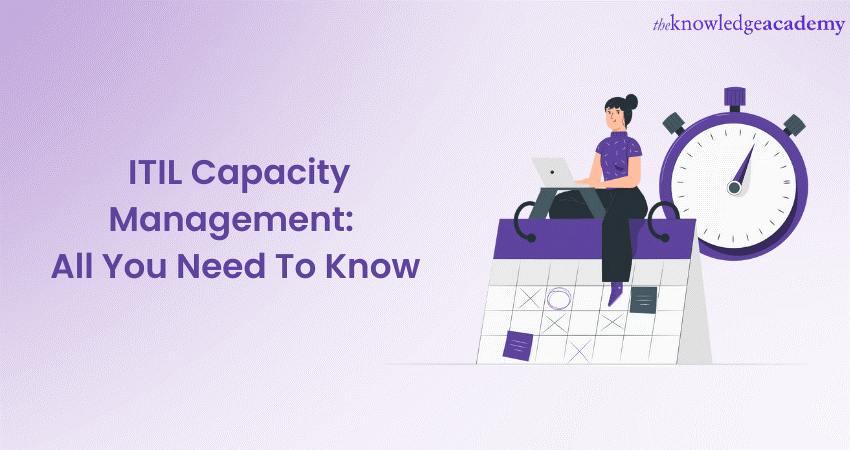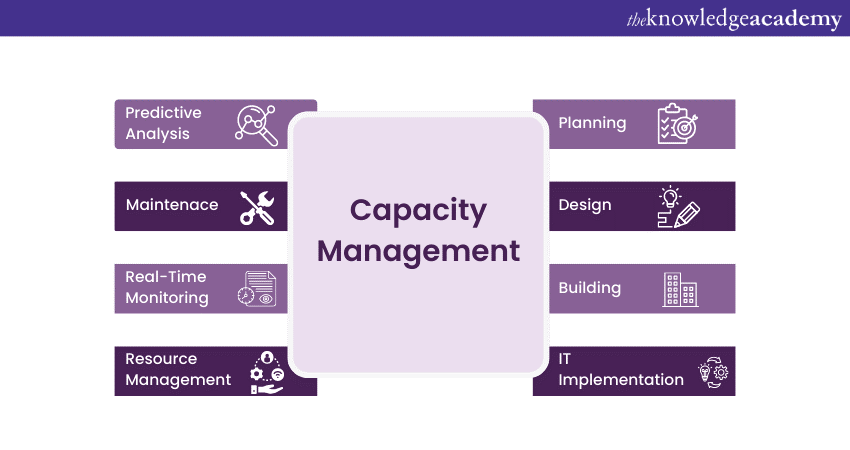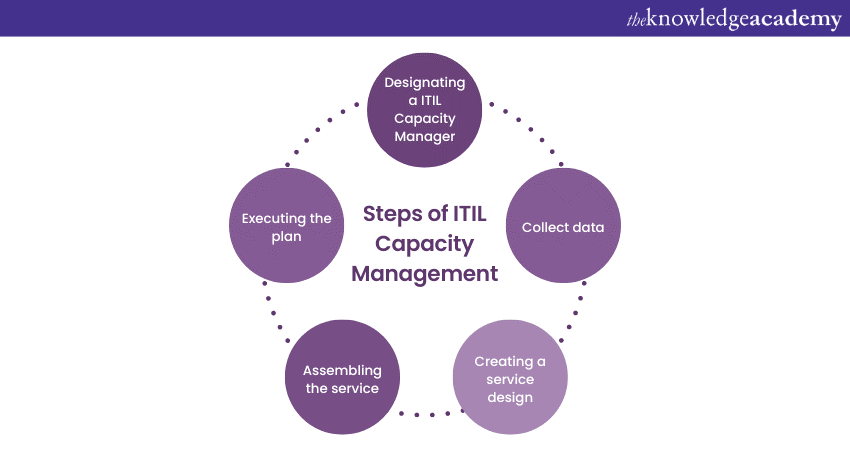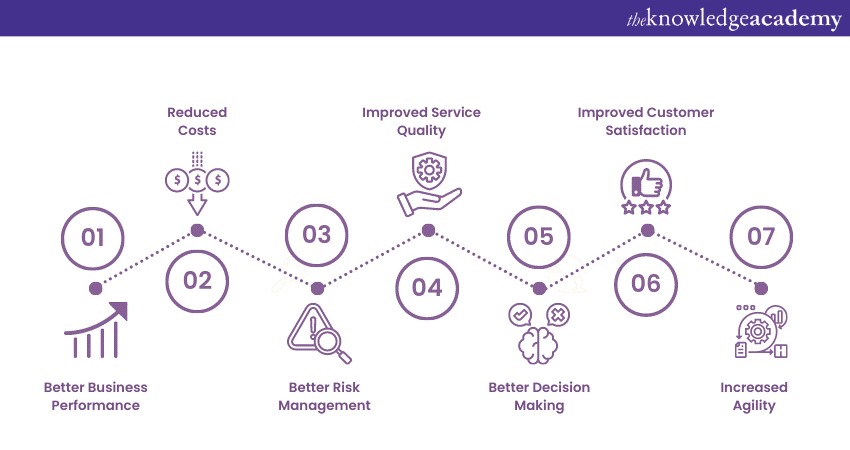We may not have the course you’re looking for. If you enquire or give us a call on 01344203999 and speak to our training experts, we may still be able to help with your training requirements.
Training Outcomes Within Your Budget!
We ensure quality, budget-alignment, and timely delivery by our expert instructors.

In today's competitive world, organisations constantly battle to deliver the best products to the end users. Ensuring a proper supply of products to meet demand is a constant battle. That is where the Information Technology Infrastructure Library or both ITIL Capacity Management and ITIL Problem Management roles and responsibilities, comes in., and it can help you meet the demand and cut costs.
There are a lot of benefits to using a Capacity Management library like ITIL. So, there is a significant demand for them. According to Statista, the revenue of IT service management software was about 1.7 billion GBP in 2021. In this blog, we discuss ITIL Capacity Management, its purpose, benefits, and the best practices to implement it.
Table of Contents
1) What is ITIL Capacity Management?
2) Purpose of ITIL Capacity Management
3) Steps of ITIL Capacity Management
4) Capacity Management Best Practices
5) Why Should I Apply Capacity Management?
6) What are the benefits of ITIL Capacity Management?
7) Conclusion
What is ITIL Capacity Management?

The ITIL Capacity Management, an integral component along the ITIL certification path, is a procedure part of the service design lifecycle phase.

Purpose of ITIL Capacity Management
With the inclusion of ITIL 4 DPI principles, organisations further optimises their capacity management practices, aligning with evolving digital requirements. So, reducing costs and maintaining the quality of service is one of its essential purposes.
As an ITIL Capacity Manager, you must know the capacity to provide your organisation's current and future services. Most importantly, this analysis should be done quickly and efficiently without breaking the budget goals. Some of the responsibilities of an ITIL Capacity Manager are listed below:
a) Tracking the implemented processes
b) Examine its efficiency
c) Analysing the pace and stability of the processes
d) Find out areas for improvements
Start with the ITIL Training Course to learn the world’s leading IT Service Management framework.
Steps of ITIL Capacity Management

It is a continuously evolving process that requires proper planning, plotting, conditioning, handling, evaluating, and reviewing. In this section, you will learn Capacity Management with step-by-step instructions.
1) Designating an ITIL Capacity Manager: In this step, you must hire an ITIL Capacity Manager or designate someone for that role. Based on your organisation’s size and requirements, you need to expand or contract the size of your Capacity Management team.
2) Collect data: Once the Capacity Management team is fixed, you can focus on the next process and find out the requirements of your business. Specify your organisation's current Capacity first to determine your future capacity requirements. Apart from this, assign your team to the following responsibilities:
a) Analysing the existing Capacity
b) Creating goals
c) Calculating the efficiency and fruitfulness of the existing Capacity infrastructure
d) Tracking performance Management by stocking the software and other tools
e) Improving Capacity Management measures by upgrading existing tools and software
f) Planning the budget and figuring out the costs by working with the finance manager
g) Find out areas of weakness and look for ways to improve them with new tools, training and software solutions
3) Creating a service design: Once all the necessary data is collected, creating a service design plan is time. While creating this service design plan, consider the following measures:
a) An estimation of the expected costs and budget
b) Find out the resources necessary for creating all the processes, including the tools, services and manpower
c) Identify an area for implementing Capacity Management
d) Identify the task flow of all the processes from inputs to the outputs
e) Determine the work required to obtain and implement the tools and software for Capacity Management
f) Determine the level of training needed and its timeline
g) Estimating the timeline for implementing all of these processes
4) Assembling the service: Now that you have an effective service design plan, you can start building the service. Before building the service, you should consider the following criteria:
a) Find out your estimated team size and whether you need to hire more people
b) Obtain the required tools and software to track the performance of the Capacity infrastructure
c) Whether it’s a simple plan or budget report ensure to document all the details
5) Executing the plan: Once all the steps from planning the service design to assembling the service are done, it's time to execute the plan in your organisation. After executing the plan, track and see if there's any progress. Continue monitoring to determine what works well and which areas require optimisation.
You can fulfil your organisation's capacity requirements by repeatedly redoing these steps. Apart from this, it helps regular improvement of the existing processes and ensures they meet any requirements in the future.
Capacity Management best practices
Capacity Management is a process that requires continuous monitoring and tweaking. You can develop best practices as your organisation grows and all the processes are well organised. Consider incorporating principles from related disciplines, such as ITIL Knowledge Management, to enhance your analytical capabilities.Some of the best practices are listed below:
Designate the right person for the job
One of the critical steps in implementing Capacity Management is effectively utilizing the workforce consideration integral to ITIL careers. Ensure that you have the right person for the job and that person works at the right place when needed. So, hiring well-qualified persons that suit your project needs is very important. Instead of hiring new people, you can also train and promote your employees accustomed to your products and culture.
Learn from the experience
You must learn from your and your competitor's mistakes and find out how to overcome them. Many people try to learn from their mistakes and often forget to learn from their successes. So, read about successful reports and try to combine your lessons from failures and successes to have a significant impact.
Sensitivity analysis
Sometimes things don't go according to your plan, so performing a "What if" analysis is best before implementing Capacity Management. Such analysis can help you find out worst-case scenarios and helps you better prepare for them. Having backup plans can come in handy when things go wrong and will help you get back on track quickly.
Organise priority tasks
A well-oiled engine can run for a long time without any hassles; likewise, when the team's tasks are well-organised, they can perform better. So, organise the team's work based on priority and ensure the critical tasks are performed first. This will improve the efficiency of the work and prevent any hassle.
Signup for our course on ITIL® 4 Strategist: Direct, Plan and Improve DPI and understand the role of Governance, Risk and Compliance.
Why should I apply Capacity Management?
ITIL Capacity management generally forces an organisation to maximise its capabilities by making deliberate choices. Understanding the ITSM vs ITIL distinction is crucial for organisations to align IT Service Management with their overall goals, guiding strategic decisions in IT practices.
Organisations can cut back on their IT budget and improve the quality of service by implementing Capacity Management in ITIL. Here are the various possibilities for organisations that apply ITIL Capacity Management methodologies:
1) Improvement in IT costs for each service unit position
2) Leveraging the existing IT resources
3) Fine-tuning applications and infrastructure components
4) Improving performance, reducing consumption and delaying IT upgrades
5) Elimination of redundant work
6) Maintaining consistency in reporting
7) Efficient provision of capacity
8) Utilising timely capacity and related cost details to make better-informed business decisions
9) Offering insight into the Total Cost of Ownership (TCO) of IT upgrades and other initiatives
10) Predict the future usage depending on the growth levels
11) Stopping the unveiled bottlenecks in time to stop them before they affect the service
The above pointers demonstrate that the ITIL Capacity Management teams work closely with the ITIL Service Level Management and the ITIL Financial Management areas. A practice that also intersects with considerations within ITIL Asset Management. More importantly, the procedures in Capacity Management result in a more thorough service level and related financial information for the organisation’s business outcomes. As a result, leaders make better-informed decisions.
Moreover, Capacity Management is generally the first step to an ITIL Service Delivery initiative because it offers organisations fast and early wins. These wins translate to an increase in the budget, which funds the remainder of the ITIL project and enhances ITIL Project Management.
The recovery of implementation costs and demonstration of success help keep the project afloat. This not only encourages upper management to stay committed to their course but also mitigates resistance within the organisation, aligning with the principles of ITIL Incident Management.
Therefore, proper planning, monitoring, analysing and optimising IT resources and the existence of an infrastructure model ensure the service levels are fulfilled. Needs must be forecasted, and a capacity plan that contains the current use of the service levels is key. More importantly, a collaborative culture being practised with input from other teams to develop the
What are the benefits of ITIL Capacity Management?

It is a practice that helps organisations optimise their IT infrastructure resources to ensure that they are available to meet business demands. There are various advantages and disadvantages when comparing ITIL v3 vs ITIL v4, which contribute to enhancing their utility and effectiveness for organizations. Understanding the advantages of ITIL Capacity Management is crucial for optimizing IT resources. ITIL Release Management, an essential aspect of ITIL, is significant in ensuring effective capacity planning and utilization.The benefits of implementing Capacity Management include:
a) Better business performance: It assists organisations in making sure that their IT infrastructure is constantly accessible to fulfil business demands. The organisation can provide clients with high-quality services because IT resources are optimised.
b) Reduced costs: Optimising IT resources can help organisations reduce their costs. Organisations can avoid investing in unnecessary hardware, software, and other IT resources by ensuring that resources are used effectively.
c) Better risk management: It can help organisations identify potential risks in their IT infrastructure and take steps to mitigate them. This can help organisations avoid downtime, data loss, and other costly problems.
d) Improved service quality: It helps organisations ensure that their IT infrastructure is always available to meet the demands of the business. This means that services are delivered consistently and with high quality.
e) Better decision-making: By providing visibility into IT infrastructure, Capacity Management can help organisations make better decisions about IT investments, resource allocation, and service delivery.
Conclusion
We hope you understood everything about ITIL Capacity Management from this blog. Apart from this, you would have learned in depth about the purpose and benefits of Capacity Management. Implementing it will improve your work efficiency and reduce operational costs. As you apply these learnings in your professional journey, ITIL Certification Renewal becomes your compass, guiding you towards continued success and excellence in the dynamic realm of IT service management. Reinforce your understanding by exploring our blog on ITIL Interview Questions that can be a practical way to solidify your knowledge and readiness in this area.
Signup for our courses on ITIL® Training and learn to manage the entire service lifecycle from development to improvement.
Frequently Asked Questions
Upcoming IT Service Management Resources Batches & Dates
Date
 ITIL® 4 Foundation Certification Course
ITIL® 4 Foundation Certification Course
Mon 29th Jul 2024
Wed 31st Jul 2024
Mon 5th Aug 2024
Wed 7th Aug 2024
Sat 10th Aug 2024
Mon 12th Aug 2024
Wed 14th Aug 2024
Mon 19th Aug 2024
Wed 21st Aug 2024
Sat 24th Aug 2024
Tue 27th Aug 2024
Thu 29th Aug 2024
Mon 2nd Sep 2024
Wed 4th Sep 2024
Sat 7th Sep 2024
Mon 9th Sep 2024
Wed 11th Sep 2024
Mon 16th Sep 2024
Wed 18th Sep 2024
Sat 21st Sep 2024
Mon 23rd Sep 2024
Wed 25th Sep 2024
Mon 30th Sep 2024
Wed 2nd Oct 2024
Sat 5th Oct 2024
Mon 7th Oct 2024
Wed 9th Oct 2024
Mon 14th Oct 2024
Wed 16th Oct 2024
Sat 19th Oct 2024
Mon 21st Oct 2024
Wed 23rd Oct 2024
Mon 28th Oct 2024
Wed 30th Oct 2024
Sat 2nd Nov 2024
Mon 4th Nov 2024
Wed 6th Nov 2024
Mon 11th Nov 2024
Wed 13th Nov 2024
Sat 16th Nov 2024
Mon 18th Nov 2024
Wed 20th Nov 2024
Mon 25th Nov 2024
Wed 27th Nov 2024
Sat 30th Nov 2024
Mon 2nd Dec 2024
Wed 4th Dec 2024
Mon 9th Dec 2024
Wed 11th Dec 2024
Sat 14th Dec 2024
Mon 16th Dec 2024
Wed 18th Dec 2024
Mon 6th Jan 2025
Wed 8th Jan 2025
Mon 13th Jan 2025
Wed 15th Jan 2025
Mon 20th Jan 2025
Wed 22nd Jan 2025
Mon 27th Jan 2025
Wed 29th Jan 2025
Mon 3rd Feb 2025
Wed 5th Feb 2025
Mon 10th Feb 2025
Wed 12th Feb 2025
Mon 17th Feb 2025
Wed 19th Feb 2025
Mon 24th Feb 2025
Wed 26th Feb 2025
Mon 3rd Mar 2025
Wed 5th Mar 2025
Mon 10th Mar 2025
Wed 12th Mar 2025
Mon 17th Mar 2025
Wed 19th Mar 2025
Mon 24th Mar 2025
Wed 26th Mar 2025
Mon 31st Mar 2025
Wed 2nd Apr 2025
Mon 7th Apr 2025
Wed 9th Apr 2025
Mon 14th Apr 2025
Wed 16th Apr 2025
Tue 22nd Apr 2025
Mon 28th Apr 2025
Wed 30th Apr 2025
Tue 6th May 2025
Mon 12th May 2025
Wed 14th May 2025
Mon 19th May 2025
Wed 21st May 2025
Tue 27th May 2025
Mon 2nd Jun 2025
Wed 4th Jun 2025
Mon 9th Jun 2025
Wed 11th Jun 2025
Mon 16th Jun 2025
Wed 18th Jun 2025
Mon 23rd Jun 2025
Wed 25th Jun 2025
Mon 30th Jun 2025
Wed 2nd Jul 2025
Mon 7th Jul 2025
Wed 9th Jul 2025
Mon 14th Jul 2025
Wed 16th Jul 2025
Mon 21st Jul 2025
Wed 23rd Jul 2025
Mon 28th Jul 2025
Wed 30th Jul 2025
Mon 4th Aug 2025
Wed 6th Aug 2025
Mon 11th Aug 2025
Wed 13th Aug 2025
Mon 18th Aug 2025
Wed 20th Aug 2025
Mon 25th Aug 2025
Mon 1st Sep 2025
Wed 3rd Sep 2025
Mon 8th Sep 2025
Wed 10th Sep 2025
Mon 15th Sep 2025
Wed 17th Sep 2025
Mon 22nd Sep 2025
Wed 24th Sep 2025
Mon 29th Sep 2025
Wed 1st Oct 2025
Mon 6th Oct 2025
Wed 8th Oct 2025
Mon 13th Oct 2025
Wed 15th Oct 2025
Mon 20th Oct 2025
Wed 22nd Oct 2025
Mon 27th Oct 2025
Wed 29th Oct 2025
Mon 3rd Nov 2025
Wed 5th Nov 2025
Mon 10th Nov 2025
Wed 12th Nov 2025
Mon 17th Nov 2025
Wed 19th Nov 2025
Mon 24th Nov 2025
Wed 26th Nov 2025
Mon 1st Dec 2025
Wed 3rd Dec 2025
Mon 8th Dec 2025
Wed 10th Dec 2025
Mon 15th Dec 2025
Wed 17th Dec 2025







 Top Rated Course
Top Rated Course


 If you wish to make any changes to your course, please
If you wish to make any changes to your course, please


